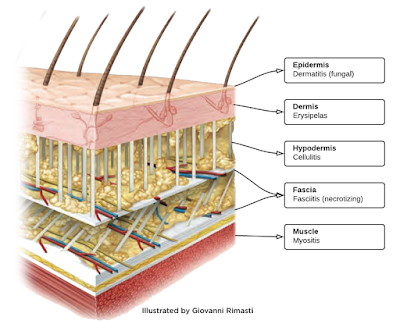Several of the previous "Spotlight on CPT" presentations revolved around lesion excision and repair, so in keeping with that theme, this discussion will address removal of lipomas.
A lipoma is a fatty tumor. You will recall the suffix - oma means tumor. This does not always signify a cancerous growth as evidenced here since lipomas are just a tumor of fatty tissue. Lipomas can be superficial, subfascial, or submuscular, and properly coding the removal of a lipoma depends on the specific depth.
Let us examine the layers of skin and subcutaneous tissue to get a better understanding of the anatomy we are dealing with.
Source: https://biology.stackexchange.com/questions/30131/what-is-our-skin-made-up-of
Source: https://www.grepmed.com/images/3881/dermatology-infections-hypodermis-epidermis-diagnosis-layers-skin
As can be identified in these illustrations, the superficial layer of the skin is the epidermis, the dermis is the middle layer, and the hypodermis or subcutaneous layer is the lowest layer. If the lipoma were located superficially, the removal of the lipoma would be coded to excision of a benign lesion. The appropriate code would fall into the CPT code range 11400-11446 based on location and size of the lipoma removed. This is advice that is supplied via the August 2006 CPT Assistant on page 10.
However, that same CPT Assistant goes on to indicate that when a lipoma is removed from the deeper subcutaneous layer, or beyond (fascia or muscle) then the appropriate code for removal will be found in the musculoskeletal section of the CPT manual. The index entry would be:
Excision
Tumor
Specific location
Therefore, if we were coding subcutaneous lipoma removal from the forearm the coding path is:
Excision
Tumor
Arm, lower...25075, 25071, 25076, 25073
The codes are divided into two categories: subcutaneous or subfascial. They are also divided by size: less than 3 cm. or 3 cm. or greater.
Here is an example:
Excision of a 4.5 cm. subcutaneous lipoma from the left forearm would be:
25071 Excision, tumor, soft tissue of forearm and/or wrist area, subcutaneous; 3 cm. or greater
Often lipomas are encapsulated and easily removed in their entirety. There are occasions when the lipoma has extensions, or finger-like projections that curl around other structures like nerves, making removal more difficult and piece-meal. Regardless of the removal, it is important to have a size provided by the surgeon so that an appropriate code can be chosen. Size is based on the greatest diameter of the lesion plus any margin just like for lesion removals discussed previously.
Remember, the simple or intermediate repair that would be used to close the excision is included in the actual removal code. However, if a complex repair, perhaps one that would necessitate the undermining of skin, was performed, that can be separately coded. This information is in the Note section found immediately at the beginning of the musculoskeletal system chapter of the CPT Manual.
Now, light has been shed on proper coding for excision of lipomas.
About the Author
Dianna Foley, RHIA, CHPS, CCS is OHIMA's Coding Education Coordinator. Dianna has been an HIM professional for 20 years. She progressed through the ranks of coder, department supervisor, and department director, to her current role as a coding consultant.
She recently served as the program director for Medical Coding and HIT at Eastern Gateway Community College. Dianna earned her bachelor's degree from the University of Cincinnati subsequently achieving her RHIA, CHPS, and CCS certifications. She is an AHIMA Approved ICD-10-CM/PCS Trainer and a a presenter at regional HIM meetings and the OHIMA Annual Meeting.


